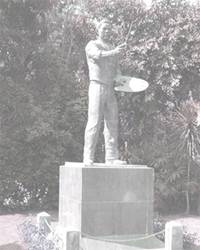"BRIEF
HISTORY OF BADOC
ILOCOS NORTE"

Badoc was
established as a pueblo (town) in 1714 by the Augustinian friars. It is believed
that the late founding of the town of
Badoc
was due to the unsettled peace and security conditions of the place at the
time. 'the Badoc Island, known as “Puro," situated about two
kilometers seaward from the coastline of the coastal barangay, Paguetpet, was
said to be the favorite haven or hangout of fierce and hostile Moro and Zambal
marauders. They stayed long in the island, because they were afraid to move out
to neigh-boring towns which had good security forces.
These ruthless marauders raided repeatedly the undisturbed
villages south of the
port
of
Gaang
, Curimao, refraining from moving north near Paoay, whose security force could
be strengthened easily and aided by those from Batac. Their stay greatly
contributed to the delay in the establishment of the town. It was only after the
pirate marauders moved out that the town was deemed officially founded.
The establishment of the town as a parish in 1714 was also
the approximate start of the construction of the Spanish built Catholic church,
known as the
Saint John
the
Baptist
Church
. It is said that the place of the Isneg settlement, wherein the first Spanish
missionary team also established camp, was the seat of the Christianization of
the town. This explains why the name
Canaan
, meaning "refuge of new Christians" was given to the area. It was
also in the place where the church was established and where the first mass was
said by Padre de Alvarado, an Augustinian priest who was the spiritual adviser
of the expedition led by the youthful Spanish conquistador, Juan de Salcedo. The
first mass, which was celebrated on June 24, 1572, or more than two centuries
before the construction of the Catholic church, was said in thanks-giving for
the peace treaty between Salcedo and the native leaders and was also dedicated
to those who were slain in battle It coincided with the feast day of Saint John
the Baptist, who was made Badoc's patron saint.
Before the coming of the Spanish colonizers, the place was
inhabited by some Isneg families. These were the earliest settlers and they
established their huts in a clearing called
Canaan
, situated along the bank of the brook which was known as Pagdanuman (water
source). All around the settlement was a thick growth of a native weed known to
the settlers as bado-badoc. This weed was very valuable to the Itnegs, because
its flowers, dipped in oil extracted by cooking process from the kernel of the
bittaog (palomaria) fruit, was used to light their huts at night and the stem
and elongated leaves were used in making the walls and fences of their homes.
In 1572, the Spaniards conducted intensive Christianization
missions and Spanish soldiers were cruising along the Pagdanuman Brook, looking
for a clearing wherein they could put up their camp when they came upon the
Isneg settlement, In a very friendly manner, they approached the native settlers
and requested that they be allowed to make camp near their settlement. But this
could only be made possible by clearing an area of the thick growth of the
Badoc-badoc weeds.
Because of the language barrier, the Spaniards signified
their intention by the use of signs. The soldiers pointed to the area that they
desired to weed out for their camp site, At the same time, they signalled their
request for help in the clearing activities. Unable to understand what the
Spaniards desired, and believing that they merely wanted to know the name of the
weed, the leader of the settlement swung one of his arms while pointing to the
thick growth and said: "Bado-badoc, bado-badoc." The leader of the
team recorded these words; hence, the town was called Badoc.
Later, in accordance with an understanding made between the
settlers and the missionaries. the area adjacent to the Isneg settlement was
cleared of the bado-badoc weed. In spite of the good intentions of the
missionary team, that was to make camp and have a center for their
Christianization operations, the Isneg families became wary and suspicious due
to the presence of armed Spanish soldiers. One night, under the cover of
darkness, the entire Isneg group moved out eastward until they reached Ugis, a
barangay of the town of
Nueva Era
,which is adjacent to the easternmost barangay of Badoc and made their
own settlement in the area. Up to this time, the Isneg still live in Ugis.

